10 Best Whole Onions Side Dish Recipes
Onions often star in the bit parts of a meal, supporting the main players of meat and vegetables in stellar ways. But is time to consider onions as stars in the main cast. Onions are healthy, widely available and cheap. Onions have such a delightful texture and taste that can be enhanced by herbs, spices, vinegar, wines and mustard. Whole, half or quartered onions can be baked, friend, grilled, barbecued, steamed or poached. Onions can also be stuffed with various fillings. Try some of the delightful onion side dish recipes presented below as a recipe collection. Time to give the humble onions a glamorous role at your table to delight your friends and family.
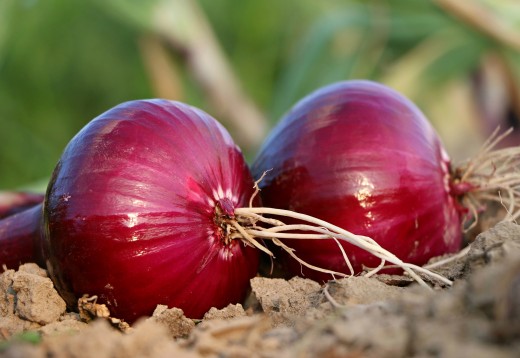
Onions are healthy and are a versatile healthy ingredient for many dishes. But, learn how to cook onions as a featured side dish with this recipe collection.
Baked Red Onions Glazed with Balsamic Vinegar and Mustard
Ingredients
For the onions
- 2 tablespoons olive oil
- 2 tablespoons balsamic vinegar
- 4 tablespoons fresh oregano, finely chopped
- 4 medium-size red onions (peeled to remove papery skins)
For the glaze
- 1 tablespoon balsamic vinegar
- 2 tablespoons extra virgin olive oil
- 1 teaspoon good quality Dijon mustard
Method
Preheat your oven to 400 degrees F (200 degrees C). Cut the onions vertically in half from top to bottom, leaving the stalk part and root intact, but removing the skins. Then, slice each half into two wedges, retaining the root to keep the wedges intact. Place the onion wedges into a baking dish, packing them tightly together. Sprinkle the onions with the olive oil and balsamic vinegar. Season with salt, freshly ground black pepper, and 1 tablespoon of the oregano. Cover the baking dish with foil and roast the onions for about 30 minutes. Remove the foil and bake the onions uncovered for an additional 20-30 minutes, or until the onions are just tender. Meanwhile, make the glaze by whisking the balsamic vinegar, salt, mustard and pepper in a small bowl. Gradually drizzle in the olive oil while continuing to whisk. Pour the glaze over the roasted onions and bake for an extra 10 minutes and then drizzle with olive oil before serving warm as a side dish or accompaniment for roast or barbecued meat or vegetables.
Red Onions Baked with Honey and Herbs
Ingredients
- 1/4 cup water
- 1/2 teaspoon salt
- 3 large red onions
- 1 teaspoon paprika
- 1 teaspoon ground coriander
- 1/8 teaspoon Cayenne pepper
- 3 tablespoons butter, melted
- 1/3 cup full flavor dark honey
Method
Peel the onions and cut in half horizontally. Place cut-side down in a single layer into a greased shallow baking dish. Sprinkle with water and cover the dish with foil. Bake at 350 degrees F (190 degrees C) for about 30 minutes. Flip the onions over. Combine remaining ingredients and use about half to baste the onions. Return the onions to the oven and bake, uncovered, for about 20 minutes. Use remaining honey mixture to baste the onions while completing the cooking until the onions are tender and slightly brown.
Whole Onions and Vegetables Poached in White Wine, Vinegar and Mixed Spices
Ingredients
- 12 onions, red or white
- 2 small fennel bulbs, quartered
- 2 medium courgettes, cut into thick slices
- 6 medium carrots, peeled and halved lengthwise
For the poaching liquid
- 1 bay leaf
- 1 small bunch thyme
- 475 ml (1 pint) water
- 1 small lemon, sliced
- 1 teaspoon fennel seeds
- 1 teaspoon coriander seeds
- 1 teaspoon black peppercorns
- 2 teaspoons salt, or to taste
- 475 ml (1 pint) dry white wine
- 6 garlic cloves, thickly sliced
- 2 tablespoons white wine vinegar
- 475 ml (1 pint) extra virgin olive oil
Method
Combine all the poaching liquid ingredients in a non-reactive heavy-bottomed pot and bring to the boil. Then, reduce the heat and simmer gently for about 5 minutes. Adjust the seasoning with extra salt and pepper. Cook the vegetables in the liquid until they are just tender. Each type will require a different time. When all vegetables have been cooked and removed, strain and cool the poaching liquid. Return the vegetable to the liquid and set aside in the refrigerator for several hours of overnight. Reheat the vegetables before serving warm, basted with the poaching liquid.
Turkish Style Fried Pomegranate Onions with Pomegranate Molasses
Ingredients
- 3 teaspoons sumac
- 1 teaspoon salt flakes
- 2 tablespoons vegetable oil
- 2 tablespoons fresh parsley, finely chopped
- 3 red onions, peeled and sliced into quarters
- 4 tablespoons pomegranate molasses (or similar)
Method
Toss the quartered onions in the oil and skewer them. Fry the onions in a hot griddle pan until well-browned. Drizzle molasses over the hot onions and then sprinkle with the sumac and some salt flakes. Let the onions cool a little before sprinkling with chopped parsley and serving warm.
Creamy Onions with Mushrooms and Sage
Ingredients
- 1 teaspoon salt
- 24 small onions
- 4 tablespoons butter
- 1/2 teaspoon paprika
- 2 teaspoons dried sage
- 2 teaspoons lemon zest
- 2 teaspoons lemon juice
- 2 cups half-and-half cream
- 12 fresh mushrooms, sliced
- 2 tablespoons all-purpose flour
- 4 tablespoons fresh parsley, finely chopped
Method
Peel the onions and trim the top and bottom, leaving enough to keep the onions together. Simmer the onions in salted water until tender (about 20-30 minutes). Preheat your oven to 350 degrees F (175 degrees C). Grease a shallow baking dish with butter. Next, sauté the sliced mushrooms in butter. Add the flour and stir through. Then, gradually add the salt, sage, half and half, lemon juice and 1/2 of the lemon peel. Cook, over medium heat, stirring frequently until the sauce thickens. Place the cooked onions in the greased baking dish and douse with the mushroom sauce. Bake at 350 degrees F (175 degrees C) for about 15-20 minutes. When cooked, sprinkle the top with paprika, the chopped parsley and the remaining lemon peel. Serve warm.
Roasted Onions With Mustard and Mixed Herbs
Ingredients
- 2 red onions
- 1 yellow onion
- 1 teaspoon Dijon mustard
- 3/4 teaspoon kosher salt
- 1/4 cup extra virgin olive oil
- 1 teaspoon garlic, finely chopped
- 1/4 teaspoon freshly ground black pepper
- 2 tablespoons lemon juice, freshly squeezed
- 1/2 tablespoon fresh thyme leaves, finely chopped
- 1/2 tablespoon fresh parsley leaves, finely chopped
Method
Preheat the oven to 400 degrees F (200 degrees C). Remove the stem end and brown root base of each onion, but leave the white part of the root intact so that the onion stays intact. Carefully remove the outer papery leaves of the onion. Then, slice the onions vertically into four intact wedges. Transfer the wedges to a bowl. Make the dressing by mixing the garlic, thyme, lemon juice, mustard, salt and freshly ground black pepper in a large bowl. Slowly drizzle in the olive oil while whisking to combine. Pour the mixed dressing over the onions and toss to coat. Transfer the onions to a sheet pan using a slotted spoon, saving the remaining dressing to use as a sauce. Bake the onions for 30-40 minutes, until tender and starting to brown around the edges. Toss the onions once or twice while cooking. Remove the roasted onions from the oven, drizzle with the reserved dressing, sprinkle with parsley, season to taste and serve warm as a side dish.
Onions Stuffed with Sausage, Cream and Thyme
Ingredients
- Sea salt to taste
- 1 cup double cream
- 1 1/3 cups of water
- Black pepper to taste
- 4 medium size red onions
- 125 g (5 oz) low-fat sausage meat
- 3 tablespoons extra virgin olive oil
- Handful of thyme sprigs, plus 1 teaspoon of leaves
- 1 head garlic, remove the outer layers to expose the cloves
Method
Peel the paper layers off the onions and trim the ends, but leave the inner root-end intact. Rub the peeled and trimmed onions with some olive oil, then sprinkle with salt. Preheat your oven to 200 degrees C (400 degrees F). Place the onions into a medium casserole or baking dish with a lid. Put the garlic head in the middle of the onions and drizzle with oil. Add the thyme sprigs on top of the onions, then pour in 1/3 cup of the water to the pot. Cover the pot and roast the onions for 45-60 minutes, until the onions soften and are lightly browned. Set the onions aside to cool. Carefully spoon out the central layers from inside each onion. Fill the cavity with sausage meat. Return the stuffed onions and onion pieces to the casserole. Squeeze the soft garlic into the casserole and add the thyme leaves, cream, 1 teaspoon of salt and 1 cup of water. Return the casserole to the oven and cook for 30-40 minutes, uncovered until the sauce thickens, basting the onions regularly. Adjust the seasoning and serve warm as a side dish.
Roasted Onions Stuffed with Cashews, Bacon and Baby Spinach
Ingredients
- 1 teaspoon salt
- 3 garlic cloves, finely topped
- 1/2 cup unsalted butter, melted
- 10 medium red and yellow onions
- 1 lb (500 g) bacon, thinly sliced
- 1 1/4 cups turkey or chicken stock
- 3 celery ribs, cut into thick slices
- 1 teaspoon freshly ground black pepper
- 2 cups salted roasted cashews coarsely chopped
- 15 oz (450 g) baby spinach, trimmed and coarsely chopped
- 1 round loaf country-style bread cut into cubes and lightly toasted
Method
Preheat oven to 425°F (220 degrees C). Cut the tops and bottoms off the onions, but keep them intact. Carefully remove all but outer 2 or 3 layers from each onion using a spoon. Keep the scooped-out onion to add to the filling. Start by chopping this onion to make about 3 cups. Cook the bacon strips in a heavy skillet over moderate heat until crisp (generally about 10 minutes). Then transfer the crispy bacon onto paper towels to drain. Using the same skillet add the celery, chopped onion, salt and pepper and sauté over moderately to high heat, stirring frequently, until the vegetables are softened (about 5 minutes). Add the garlic and fry stirring for about 1 minute. Transfer the mixture to a medium size bowl and add the bread, cashews, spinach, butter, bacon and 1 cup of stock, combining well and allowing to cool. Place the onion shells into a greased baking pan, then add 1/2 cup water and cover pan tightly with foil. Roast the onions until tender, but not falling apart (generally about 25 to 30 minutes). Then, reduce oven temperature to 350 degrees F (175 degrees C). Remove the onion shells, one at a time, fill with a portion of the stuffing, and return to pan. Bake stuffed the onions uncovered for 25-30 minutes.
Roasted Onions Stuffed with Feta, Bread and Herbs
Ingredients
- 2 medium onions
- 1 medium egg, beaten
- 2 tablespoons olive oil
- 2 tablespoons chopped parsley
- 1 teaspoon of chopped fresh thyme
- 200 g (7 oz) feta cheese, crumbled
- 50 g (2 oz) walnut pieces, chopped
- 50 g (2 oz) white or brown breadcrumbs
- 6 pieces of sun-dried tomato, finely chopped
- 1 red chilli, seeds removed and finely chopped
Method
Preheat your oven to 190 degrees C (375 degrees F). Peel the onions leaving them whole and then slice them in half across the middle. Using a spoon remove several layers from the centre to create a cavity. Place the onion halves, cut side up, on a small baking dish. Splash water onto the dish and brush the onions with oil. Cover the dish with foil (sealing around the edge) and bake for about 45 minutes until the onions are tender. Meanwhile, finely chop the layers of onions removed to create the cavity. Heat the remaining oil in a medium sized frying pan and fry the chopped onion, for 5-10 minutes until soft and beginning to brown. Set aside to cool and then transfer to a small bowl. Add half the feta, the sun-dried tomatoes, chopped thyme, parsley, breadcrumbs, chilli, walnuts, beaten egg and mix well. Season with salt and freshly ground black pepper. Increase the oven temperature to 200 degrees C (400 degrees F). Spoon a portion of the feta stuffing into the cooked onion shells. Then, scatter the remaining cheese over the onions and sprinkle over a few thyme sprigs. Add a drizzle of oil and cook for 25 minutes until the stuffing is bubbling and the feta is golden brown.
Baked Onions Stuffed with Spicy Pork Sausage, Herbs and Cheese
Ingredients
- 1 egg, beaten
- 6 large onions
- 1/2 teaspoon paprika
- 1/2 teaspoon dried oregano
- 1/2 cup uncooked white rice
- 2 tablespoons butter, melted
- 1/4 cup chopped green bell pepper
- 8 ounce (250 g) cream cheese, softened
- 3/4 pound (350 g) ground spicy pork sausage
- 2 tablespoons fresh parsley, finely chopped
Method
Preheat oven to 400 degrees F (200 degrees C). Lightly grease a heavy baking dish with butter or spray oil. Bring 1 cup water to a boil in a small saucepan. Add the rice and stir. Then, reduce the heat, cover and simmer for 15-20 minutes. Meanwhile, heat a large pot of salted water to boiling. Peel the onions carefully, and slice off the tops. Boil the onions for 12-15 minutes, or until they are just starting to soften. Drain the onions and set aside to cool. Use a spoon to remove center segments, leaving a cavity with the shell intact. Chop the onion segments removed to make the cavities and place in a bowl. Reserve 1/2 cup of chopped onion. Fry the sausage over medium high heat until the pieces are evenly brown. Drain and set aside, keeping the drippings in the pan. Sauté the chopped green pepper and 1/2 cup chopped onion until soft. Add the green pepper, cream cheese, oregano and parsley, sausage, egg, and 1 cup cooked rice to the chopped onions in the bowl. Spoon a portion of the mixture into onion shells and place in the lightly greased dish. Stir the paprika into the melted butter and brush over the tops of onions. Cover and bake the stuffed onions in the preheated oven for about 15 minutes. Uncover, and bake an extra 5 minutes. All to cook before serving warm as a side dish.
Images for Recipes
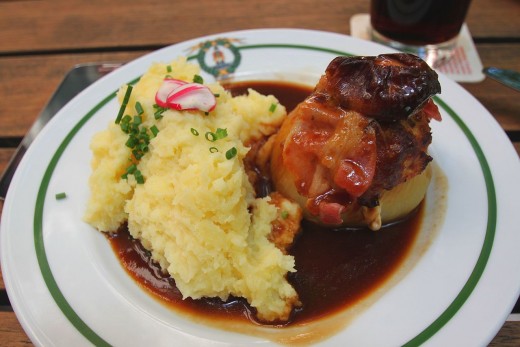
Stuffed onions make a wonderful side dish for many meat and vegetable meals.
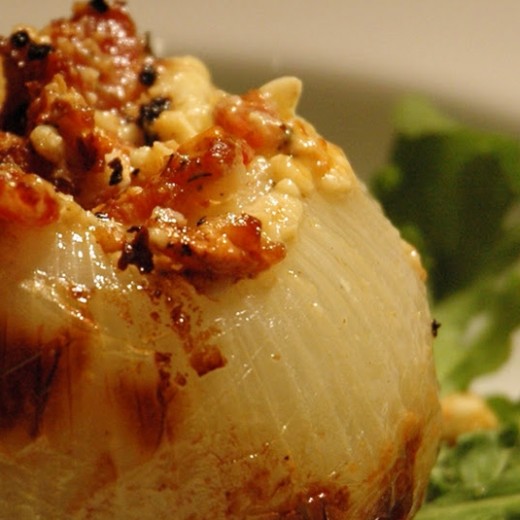
The taste and texture of whole and sectioned onions is enhanced by carefully selected fillings and toppings.
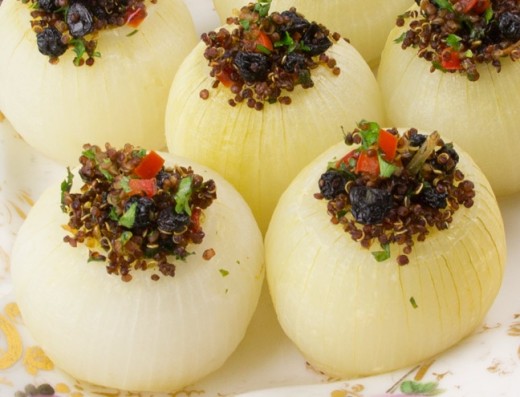
Delicately prepared soft and tender white onions with spicy topping.
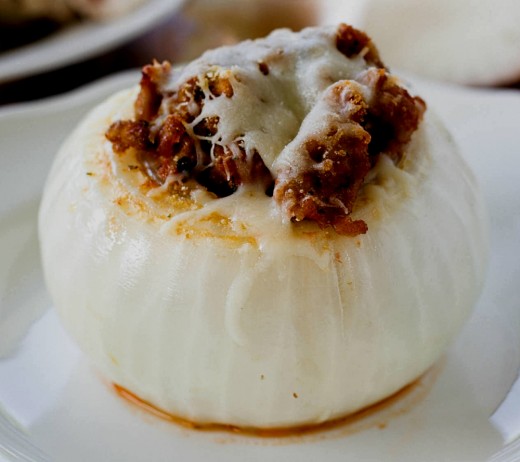
Cooking onions until the tops brown brings out the flavor.
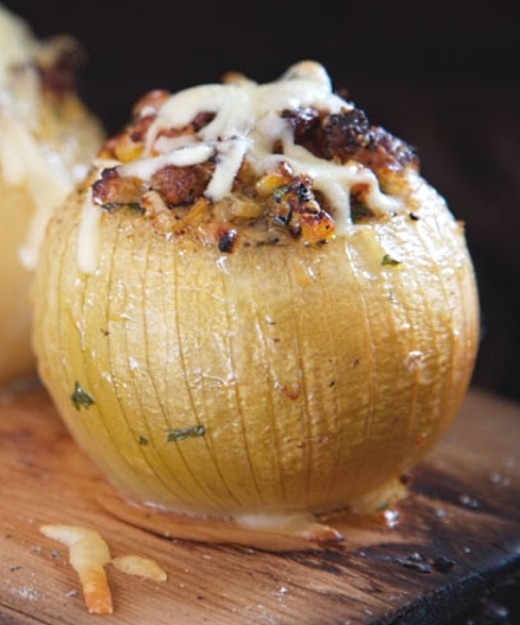
Learn how to prepare whole, half and quartered onions using this great collection of tried and tested recipes.